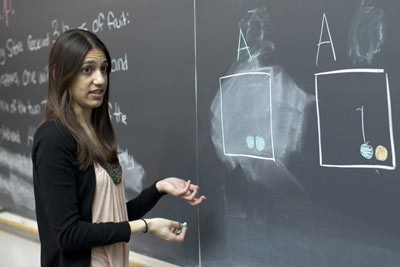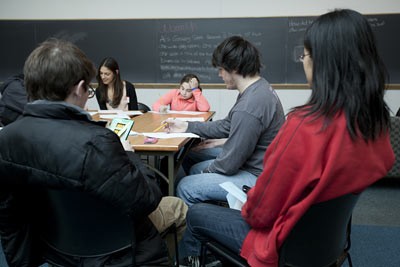Math Club hosts high schoolers for monthly puzzle night
By Linda B. Glaser
Cornell's Math Club knows how to have a good time. Twice a month, the club gathers for pizza and math puzzles, cookies and camaraderie, in the fifth-floor lounge in Malott Hall. On Feb. 2, area high school students joined club members for an evening of recreational puzzles that featured rambunctious elves, mice-gobbling cats and broken toasters. The club now plans to make this a monthly outreach event.
"We wanted to give high school students a way to engage with math in a warm and welcoming atmosphere," said Tasia Raymer, visiting assistant professor of math, who suggested inviting local students.
Lansing student Shiloh Worthington said she'd been having some trouble with math and thought Puzzle Night could be useful. "It was really fun," Worthington said. "These kinds of problems are more creative than what we usually do in school. If math were more like this, I'd like it better."
Former club president Richard Gustavson '11, a mathematics graduate student at the City University of New York, recalled that the first Puzzle Night he presided over drew a big, enthusiastic crowd, which didn't surprise him. "It's a fun exercise, and it's great for the mind," said Gustavson. "When you're doing puzzles, you're really doing what mathematicians do. It's a whole different way of thinking."
Timothy Riley, assistant professor math and club adviser, said that the puzzles also help develop critical thinking beyond math. "Puzzles stretch the imagination. They often have ingenious or quirky solutions so you have to think in original ways, and they can be doorways to grander ideas." He pointed out that puzzles have even inspired new areas of research, such as the famous Seven Bridges of Königsberg problem; its solution laid the foundations of graph theory and anticipated the field of topology.
All are welcome to Puzzle Nights, which occur every other week during the semester. "This is a social gathering as well as an intellectual exercise," said club president Nathan Jacobson '13. "People are encouraged to talk amongst themselves and discuss what they think the solution would be."
Jacobson double majors in math and philosophy because of his deep interest in logic, which he said forms the foundation of both math and philosophy. "Many people view math as computation and nothing more, but I feel that what's really crucial are the interesting proofs and truths you can discover through mathematics," he said. "The Math Club allows people to come and see that side of math."
Jacobson was quick to point out that there's nothing wrong with computation; it's what drives science and engineering. "But some people think if they're bad at computation they must be bad at math, when really there's this whole other layer to mathematics that they might be perfectly good at, and they'll never know if they don't try it."
Other Math Club activities include faculty talks, career info sessions, social events and guest lecturers. Last year's highlights featured student presentations on mathematical typesetting as well as a talk by associate professor Tara Holm, who used square dancing to introduce key ideas in topology.
"We like to integrate undergrads, grads and faculty for activities, and the Math Club is a place where this happens," said Riley.
Linda B. Glaser is staff writer for the College of Arts and Sciences.
Get Cornell news delivered right to your inbox.
Subscribe
